
The Planetary Society is an American internationally-active non-governmental nonprofit organization. It is involved in research, public outreach, and political space advocacy for engineering projects related to astronomy, planetary science, and space exploration. It was founded in 1980 by Carl Sagan, Bruce Murray, and Louis Friedman, and has about 60,000 members from more than 100 countries around the world.
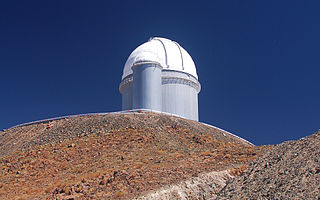
The ESO 3.6 m Telescope is an optical reflecting telescope run by the European Southern Observatory at La Silla Observatory, Chile since 1977, with a clear aperture of about 3.6 metres (140 in) and 8.6 m2 (93 sq ft) area.
Mu Arae, often designated HD 160691, officially named Cervantessur-VAN-teez, is a main sequence G-type star approximately 50 light-years away from the Sun in the constellation of Ara. The star has a planetary system with four known extrasolar planets, three of them with masses comparable with that of Jupiter. Mu Arae c, the innermost, was the first hot Neptune or super-Earth discovered.
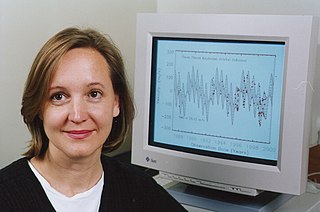
Debra Ann Fischer is a professor of astronomy at Yale University researching detection and characterization of exoplanets. She was part of the team to discover the first known multiple-planet system.

The High Accuracy Radial Velocity Planet Searcher (HARPS) is a high-precision echelle planet-finding spectrograph installed in 2002 on the ESO's 3.6m telescope at La Silla Observatory in Chile. The first light was achieved in February 2003. HARPS has discovered over 130 exoplanets to date, with the first one in 2004, making it the most successful planet finder behind the Kepler space observatory. It is a second-generation radial-velocity spectrograph, based on experience with the ELODIE and CORALIE instruments.
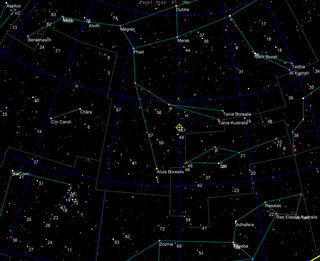
47 Ursae Majoris, formally named Chalawan, is a yellow dwarf star approximately 45.3 light-years from Earth in the constellation of Ursa Major. As of 2011, three extrasolar planets are believed to orbit the star.
HD 102195 is an orange-hued star in the zodiac constellation of Virgo with a confirmed exoplanet companion. With an apparent visual magnitude of 8.07, the star is too faint to be seen with the naked eye. The distance to HD 102195 can be estimated from its annual parallax shift of 34.06 mas, yielding 95.8 light years. It is moving further away from the Earth with a heliocentric radial velocity of 1.85 km/s. This is a high proper motion star and a possible member of the η Cha stellar kinematic group.

47 Ursae Majoris b, formally named Taphao Thong, is a gas planet and an extrasolar planet approximately 46 light-years from Earth in the constellation of Ursa Major. The planet was discovered located in a long-period orbit around the star 47 Ursae Majoris in January 1996 and as of 2011 it is the innermost of three known planets in its planetary system. It has a mass at least 2.53 times that of Jupiter.

47 Ursae Majoris c, formally named Taphao Kaew is an extrasolar planet approximately 46 light-years from Earth in the constellation of Ursa Major. The planet was discovered located in a long-period around the star 47 Ursae Majoris. Its orbit lasts 6.55 years and the planet has a mass at least 0.540 times that of Jupiter.

Stéphane Udry is an astronomer at the Geneva Observatory in Switzerland, whose current work is primarily the search for extra-solar planets. He and his team, in 2007, discovered a possibly terrestrial planet in the habitable zone of the Gliese 581 planetary system, approximately 20 light years away in the constellation Libra. He also led the observational team that discovered HD 85512 b, another most promisingly habitable exoplanet.

Doppler spectroscopy is an indirect method for finding extrasolar planets and brown dwarfs from radial-velocity measurements via observation of Doppler shifts in the spectrum of the planet's parent star. As of November 2022, about 19.5% of known extrasolar planets have been discovered using Doppler spectroscopy.

55 Cancri f, also designated Rho1 Cancri f and formally named Harriot, is an exoplanet approximately 41 light-years away from Earth in the constellation of Cancer. 55 Cancri f is the fourth known planet from the star 55 Cancri and the first planet to have been given the designation of "f".

WASP-13b, also known as Cruinlagh, is an extrasolar planet that was discovered in 2008 in the orbit of the sunlike star WASP-13. The planet has a mass of nearly half that of Jupiter, but a radius five-quarters of the size of Jupiter. This low relative mass might be caused by a core that is of low mass or that is not present at all.
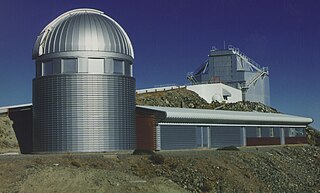
Leonhard Euler Telescope, or the Swiss EULER Telescope, is a national, fully automatic 1.2-metre (47 in) reflecting telescope, built and operated by the Geneva Observatory. It is located at an altitude of 2,375 m (7,792 ft) at ESO's La Silla Observatory site in the Chilean Norte Chico region, about 460 kilometers north of Santiago de Chile. The telescope, which saw its first light on 12 April 1998, is named after Swiss mathematician Leonhard Paul Euler.
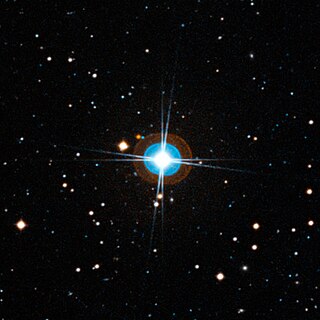
HD 10180, also designated 2MASS J01375356-6030414, is a Sun-like star in the southern constellation Hydrus that is notable for its large planetary system. Since its discovery, at least six exoplanets have been observed orbiting it, and some studies have proposed up to nine potential planets, which would make it potentially the largest of all known planetary systems, including the Solar System.

ESPRESSO is a third-generation, fiber fed, cross-dispersed, echelle spectrograph mounted on the European Southern Observatory's Very Large Telescope (VLT). The unit saw its first light on September 25, 2016.
HARPS-N, the High Accuracy Radial velocity Planet Searcher for the Northern hemisphere is a high-precision radial-velocity spectrograph, installed at the Italian Telescopio Nazionale Galileo, a 3.58-metre telescope located at the Roque de los Muchachos Observatory on the island of La Palma, Canary Islands, Spain.

Planet Hunters is a citizen science project to find exoplanets using human eyes. It does this by having users analyze data from the NASA Kepler space telescope and the NASA Transiting Exoplanet Survey Satellite. It was launched by a team led by Debra Fischer at Yale University, as part of the Zooniverse project.
Gliese 15 Ab, also commonly called Groombridge 34 Ab, rarely called GX Andromedae b is an extrasolar planet approximately 11 light-years away in the constellation of Andromeda. It is found in the night sky orbiting the star Gliese 15 A, which is at right ascension 00h 18m 22.89s and declination +44° 01′ 22.6″.
















